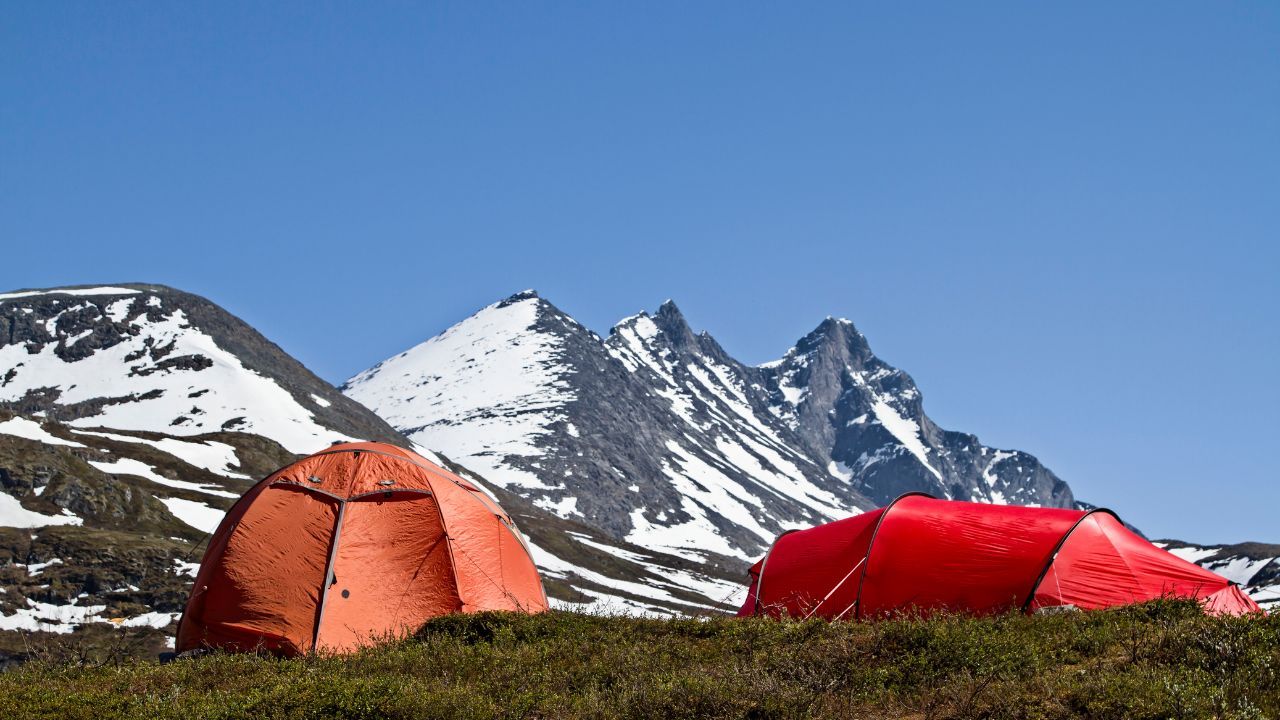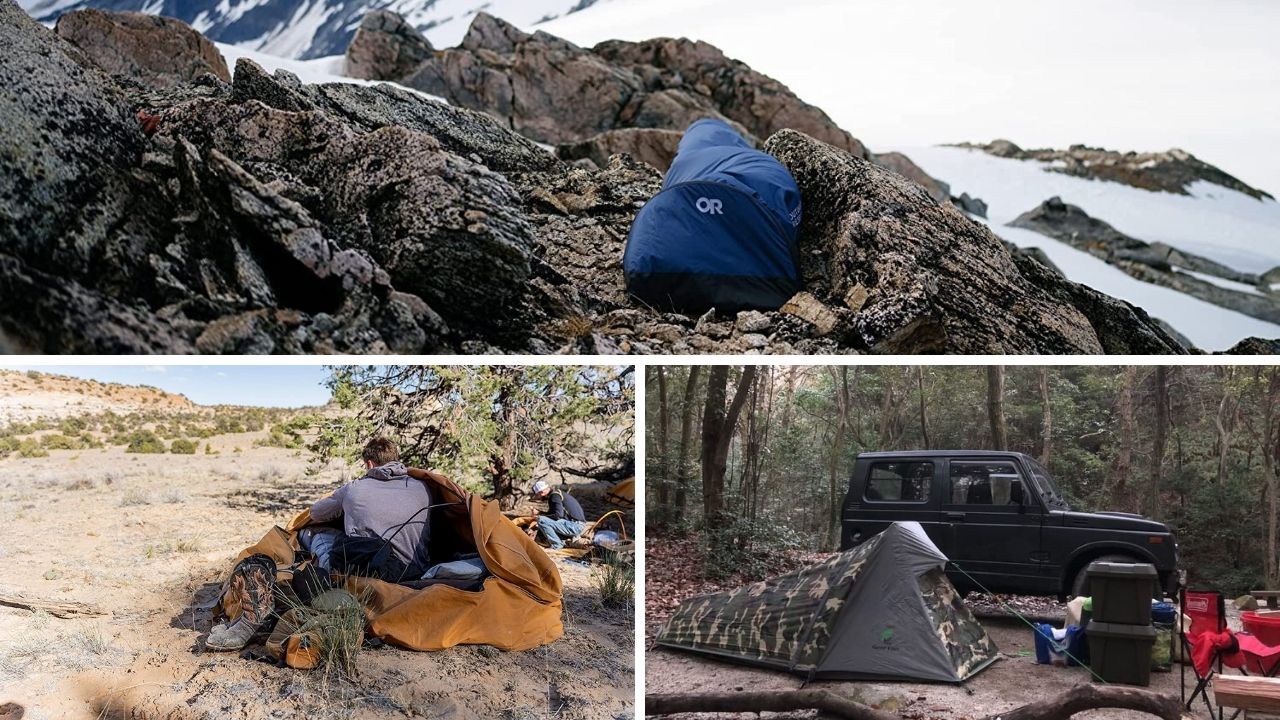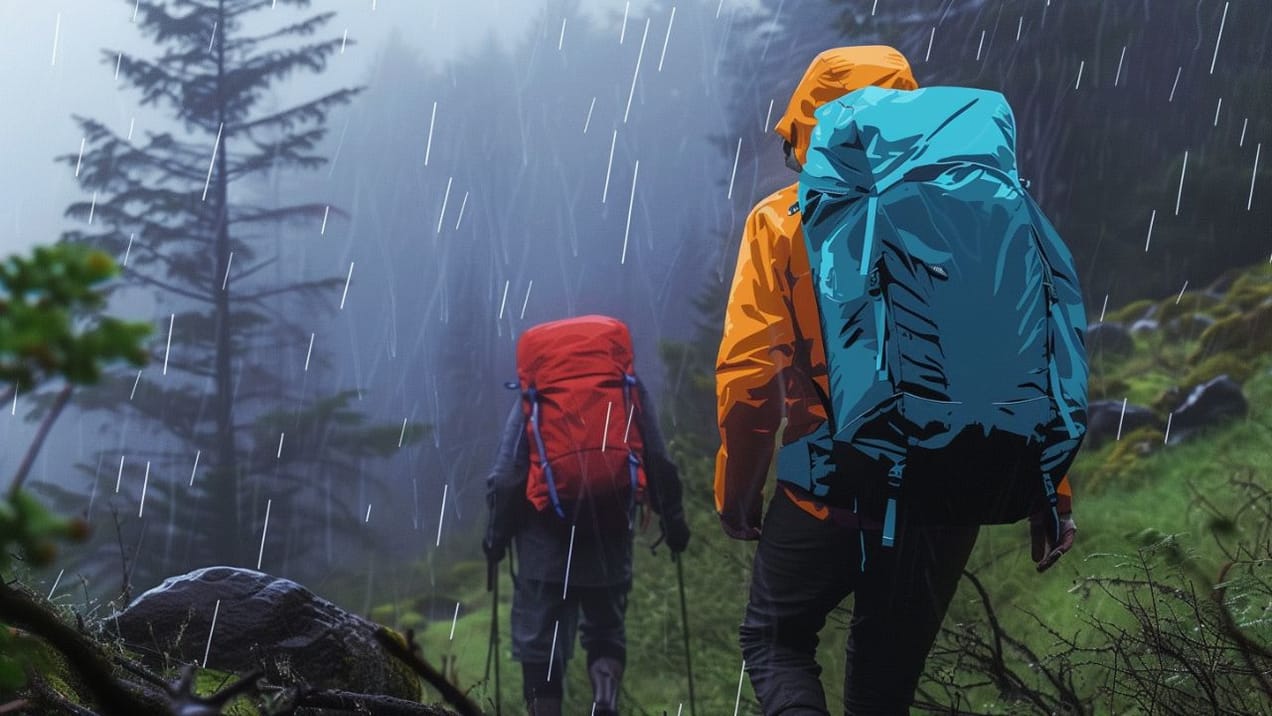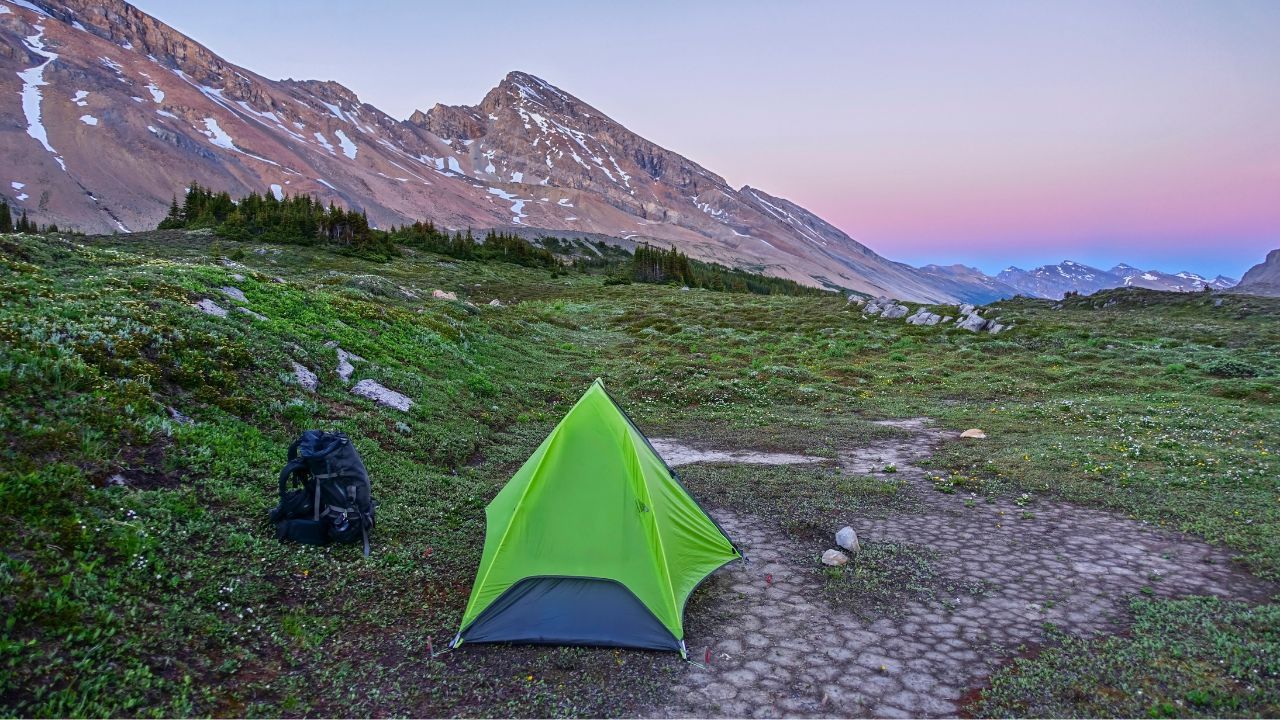
Bivy vs 1 Man Tent: Finding Your Perfect Shelter
Get clear insights into 'Bivy vs 1 Man Tent'. Learn their advantages, drawbacks, and key considerations for your next outdoor trip!
We bet you're here because you're planning your next solo adventure and wondering what kind of shelter to bring along.
Well, you've come to the right place!
Choosing the right type of shelter for your outdoor activities is crucial. It can make the difference between a comfortable night's sleep under the stars and a miserable night out in the cold.
Two popular options you might be considering are the Bivy Sack and the 1 Man Tent.
But which one is right for you?
Let's dive deeper into these two types of shelters and help you make an informed decision.
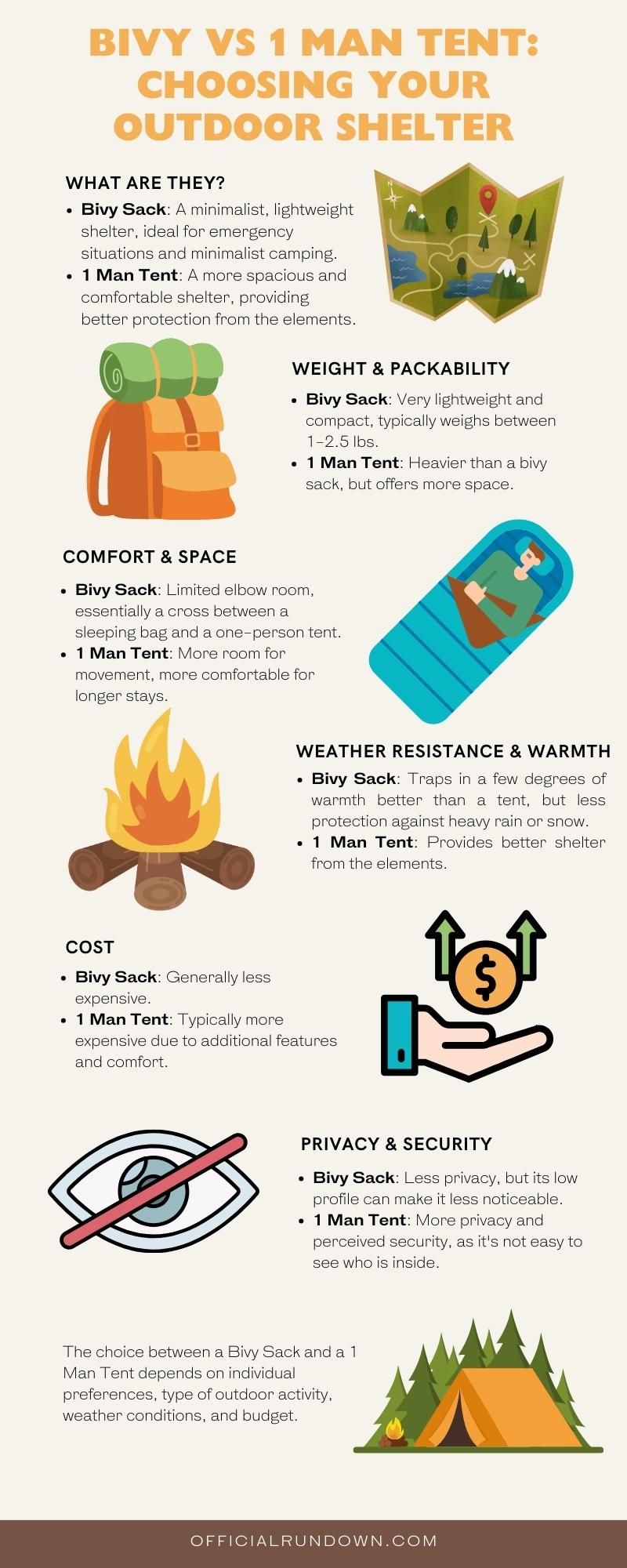
Understanding Bivy Sacks
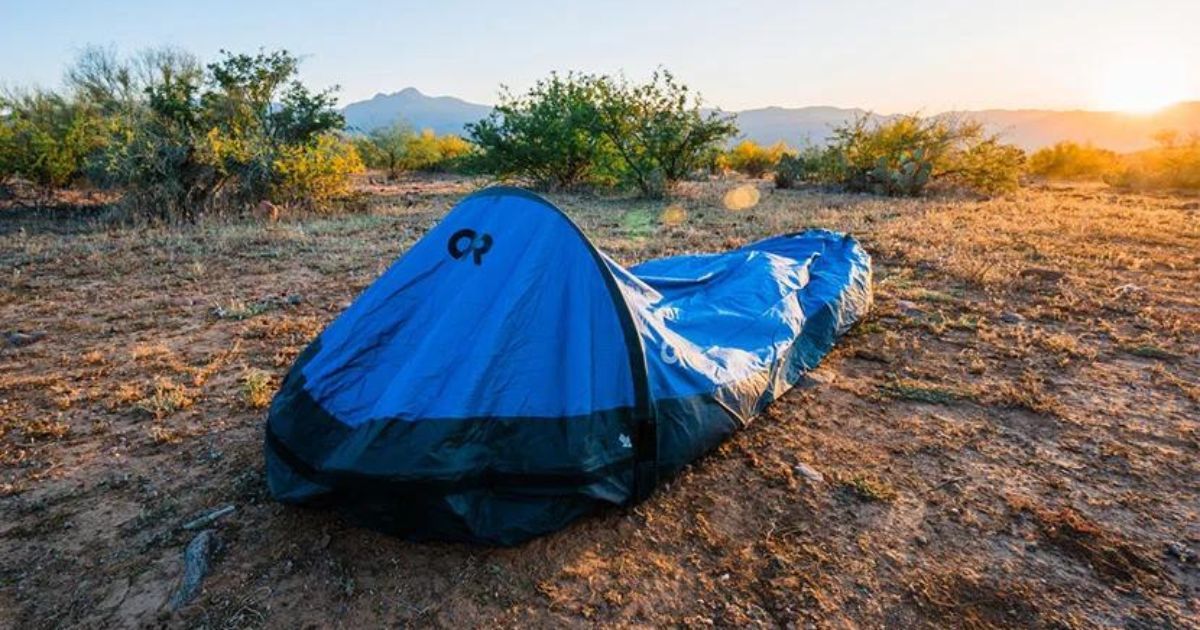
First things first, what exactly is a Bivy sack?
Short for 'bivouac sack', a Bivy is essentially a waterproof cover for your sleeping bag. Think of it as a cocoon that protects you from the elements while you sleep.
The traditional bivy sack first came into existence in the 1850s for use by climbers and mountaineers who needed lightweight and compact shelter options. They've evolved quite a bit since then, now coming in various forms designed for different uses.
There are three main types of Bivy sacks:
- Minimalist Bivy: These are the lightest and most compact, designed for fast-and-light trips where every ounce counts. Basically looks like a body bag.
- Four-Season Bivy: Built to withstand harsh weather conditions, these are heavier but offer more protection.
- Bug Bivy: These are designed primarily to keep insects at bay during warmer months.
- Bivy Tent: These are essentially a hybrid between a tent and bivy, combining the lightweight portability of a bivy with the spaciousness of a tent.
So, whether you're planning a fast-paced hiking trip or a winter mountaineering expedition, there's a Bivy sack out there to suit your needs.
Pros of Using a Bivy Sack
Lightweight and Compact Design
One of the biggest advantages of a Bivy sack is its lightness. Weighing in at just 1 to 2 pounds, it's an ideal choice for backpackers looking to cut down on weight. Plus, it's super compact! You can easily roll it up and squeeze it into your backpack.
Quick and Easy Setup
With a Bivy sack, you won't have to worry about complicated setup processes. No need for poles or stakes - simply pull it out of your pack, slide in your sleeping bag, and voila! You're ready for a good night's sleep.
Close Connection to Nature
A Bivy sack offers an unparalleled experience of sleeping under the stars. With no walls or roof to separate you from nature, you get to feel the cool breeze on your face and wake up to the first rays of the sunrise. Talk about a perfect outdoor experience!
Stealth Camping
If you're a fan of stealth camping, a Bivy sack is your best bet. They don't require any setup, take up very little space, and have a low profile. So, it's much easier to find hidden places where you can spend the night undetected. For example in between bushes or tucked up against a large rock to block any wind.
Cons of Using a Bivy Sack
Limited Space and Comfort
While Bivy sacks are convenient, they aren't the most comfortable. The space inside a Bivy is limited, meaning you won't be able to move around much. If you're someone who likes to toss and turn or stretch out while sleeping, a Bivy sack might not be the best choice for you.
Condensation Issues
Bivy sacks are designed to be waterproof, which means they can sometimes trap condensation inside. This can lead to a wet sleeping bag - not exactly what you want when you're out in the wild!
Limited Protection from Harsh Weather Conditions
Although some Bivy sacks are designed for four-season use, they may not offer as much protection from harsh weather conditions as a tent would. In heavy rain or snow, you might find yourself longing for a bit more shelter.
Exploring 1 Man Tents
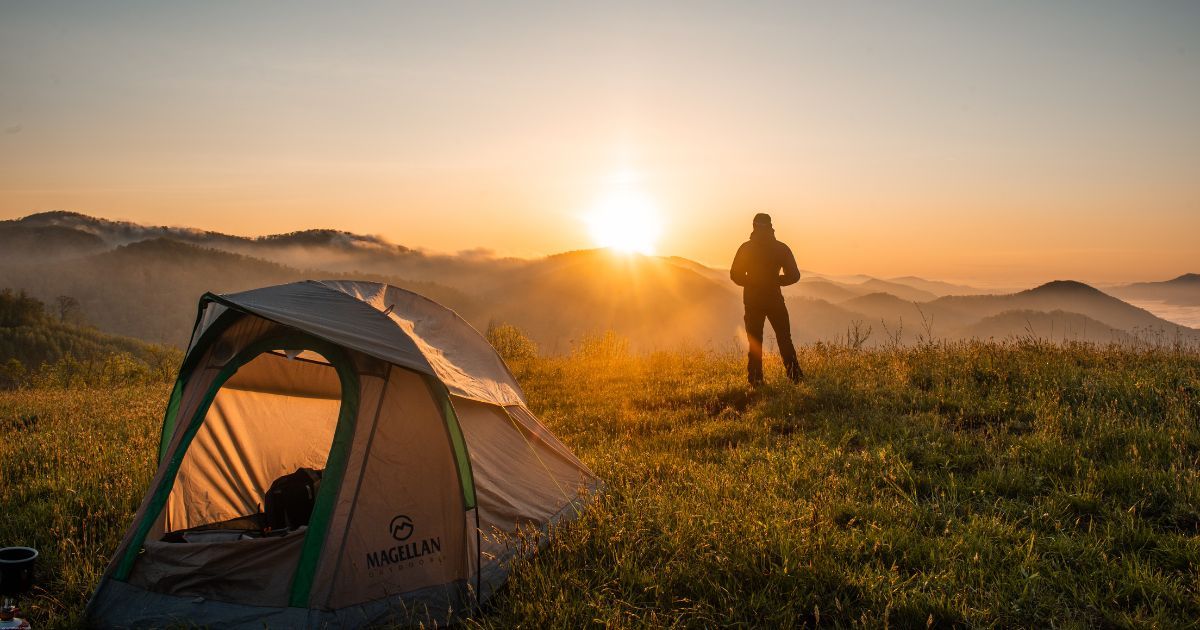
Let's now turn our attention to 1 Man Tents.
As the name suggests, these tents are designed to accommodate one person. They come with a sleeping area and usually enough space to store your gear.
1 Man Tents have been around for a long time, with the earliest examples dating back to the times of nomadic tribes.
Over the years, they've evolved greatly, with modern designs offering a variety of features like multiple doors, vestibules for gear storage, and even skylights!
Today, you'll find a wide range of 1 Man Tents available, from ultralight options for backpackers to more robust designs for car camping and long-term wilderness stays.
Pros of a 1 Man Tent
Increased Comfort and Space
Unlike a Bivy sack, a 1 Man Tent provides enough space for you to move around. Some even come with enough room to sit up and read or change clothes, making them a more comfortable option for longer trips.
Better Protection Against Weather Conditions
When it comes to weather protection, 1 Man Tents certainly have the upper hand. They provide a full barrier against wind, rain, and snow, ensuring that you stay dry and warm no matter what Mother Nature throws at you.
Versatility and Options for Customization
1 Man Tents offer a lot of versatility. You can choose from different shapes, sizes, and materials to suit your specific needs. Plus, many models come with optional add-ons like a footprint, gear loft, or rainfly, allowing you to customize your tent to your liking.
Cons of a 1 Man Tent
Heavier and Bulkier than Bivy Sacks
While 1 Man Tents offer more comfort and space, they are also heavier and bulkier. This might not be a problem for car campers, but for backpackers, every ounce counts.
More Complex Setup Process
Setting up a 1 Man Tent can be a bit more complex compared to a Bivy sack. You'll need to assemble poles, stake out the tent, and possibly add a rainfly. This might not be ideal if you're arriving late at your campsite or setting up in bad weather.
Potential for Feeling Isolated
While some people enjoy the solitude that a 1 Man Tent offers, others might find it isolating. With a Bivy sack, you're more connected to your surroundings. But in a tent, you're enclosed in your own little world. It's something to consider based on your personal preference.
Bivy vs 1 Man Tent: A Comparative Analysis
Weight and Portability
When it comes to weight and portability, the Bivy sack takes the cake. Its lightweight and compact design make it the perfect choice for backpackers and climbers. On the other hand, a 1 Man Tent tends to be heavier and bulkier, but might be a great option if you're car camping or don't have to carry it long distances.
Setup Time and Ease of Use
Bivy sacks are a breeze to set up - just roll it out, hop in, and you're good to go! 1 Man Tents, however, require more effort. You'll need to assemble poles, stake out the tent, and potentially add a rainfly. If quick setup and takedown is your priority, a Bivy sack wins this round.
Comfort and Space
In terms of comfort and space, a 1 Man Tent outshines a Bivy sack. With more room to move, sit up, or even change clothes, a tent provides a more comfortable sleeping environment. A Bivy sack, while compact and cozy, does not provide much space beyond what's needed to sleep.
Weather Resistance and Durability
Both Bivy sacks and 1 Man Tents offer protection against the elements, but a tent generally offers better weather resistance. It provides a full barrier against wind, rain, and snow, while a Bivy sack might leave you feeling exposed in harsh conditions.
Cost Comparison
Price can vary widely for both Bivy sacks and 1 Man Tents depending on the brand, materials, and features. Generally, a good quality Bivy sack can cost between $100 and $300, while 1 Man Tents usually range from $150 to over $500.
Key Considerations When Choosing Between a Bivy and a 1 Man Tent
Now that we've compared both options, let's take a look at some key considerations that can help you decide which one is right for you:
Type of Outdoor Activity
Are you planning a fast-paced hiking trip, a climbing expedition, or a relaxed camping trip? Bivy camping is best suited for activities where you need to minimize weight and pack size, while a 1 Man Tent is ideal for longer stays or when comfort and space are a priority.
Weather and Season
Consider the weather conditions and the season. If you're expecting heavy rain, snow, or strong winds, a 1 Man Tent would provide better protection. For dry and mild conditions, a Bivy sack would suffice. It is important to note that certain ultra-lightweight tents may not possess the necessary durability to withstand harsh weather conditions, particularly strong winds.
Personal Comfort Preferences
Some people are perfectly comfortable in the confined space of a Bivy sack, while others prefer the roominess of a tent. Think about what would make you feel most comfortable during your outdoor adventure.
Budget
Finally, consider your budget. Both Bivy sacks and 1 Man Tents come in a wide range of prices, so choose one that fits your budget while meeting your needs.
Remember, the right shelter can make or break your outdoor experience, so take the time to choose wisely!
Frequently Asked Questions
Here are some common questions readers often have about Bivy sacks and 1 Man Tents:
Can I use a Bivy sack in winter?
Yes, you can use a Bivy sack in winter, but make sure to get a four-season model that's designed to withstand harsh weather conditions.
Is it possible to fit two people in a 1 Man Tent?
Generally, a 1 Man Tent is designed for one person. While you might be able to squeeze in another person, it would be quite cramped and uncomfortable.
How long does it take to set up a Bivy sack and a 1 Man Tent?
A Bivy sack can be set up in just a few minutes, while a 1 Man Tent might take anywhere from 10 to 20 minutes depending on the model and your experience with setting up tents.
Since most bivy sacks don't use poles or just one small pole, you simply roll it out and slide your sleeping bag inside.
Can I use a Bivy sack or a 1 Man Tent for car camping?
While both can be used for car camping, a 1 Man Tent might be a more comfortable option due to its larger space and better weather protection.
Bottom Line
So, there you have it - a complete rundown of Bivy sacks versus 1 Man Tents.
Just to recap, Bivy sacks are lightweight, compact, and easy to set up, making them ideal for fast-paced activities like hiking and climbing.
However, they do offer limited space and might not provide enough protection in harsh weather conditions.
On the other hand, a one-person tent offers more comfort and space, better weather resistance, and versatility in terms of customization. They are, however, heavier and have a more complex setup process, but these are the lightest tents you'll find.
My personal recommendation? Consider your specific needs and preferences.
If you're a minimalist backpacker who values lightness and simplicity, a Bivy sack could be your best bet. But if you prefer more comfort and don't mind carrying a bit of extra weight, a 1 Man Tent would serve you well.
I personally prefer a small tent, either a one or two-man tent for longer trips, but for a quick overnight trip, I'd use a bivy.
Remember, the most important thing is to choose a shelter that fits your needs, makes you feel comfortable, and enhances your outdoor experience. Happy adventuring!
Before You Go...
